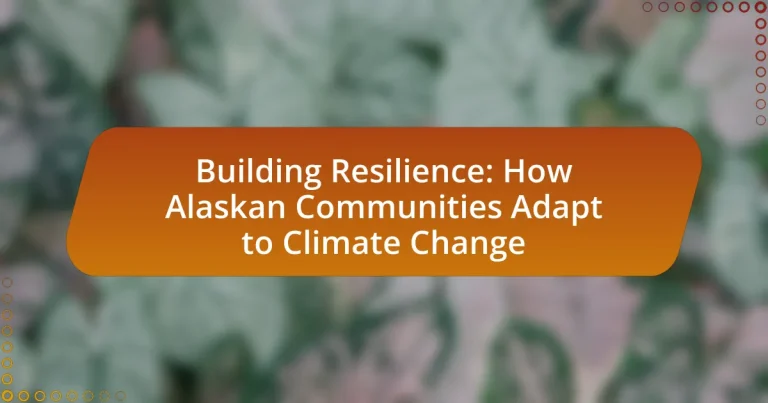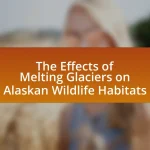The article focuses on the resilience of Alaskan communities in the face of climate change, highlighting their ability to anticipate, prepare for, respond to, and recover from environmental impacts. It discusses how these communities define resilience, the factors contributing to it, and the influence of cultural heritage on their adaptive strategies. Key challenges such as extreme weather events, financial barriers, and geographic isolation are examined, along with the role of local governments and community-led initiatives in building resilience. The article also outlines specific adaptation strategies being implemented, the importance of education, and best practices for enhancing resilience in these vulnerable communities.
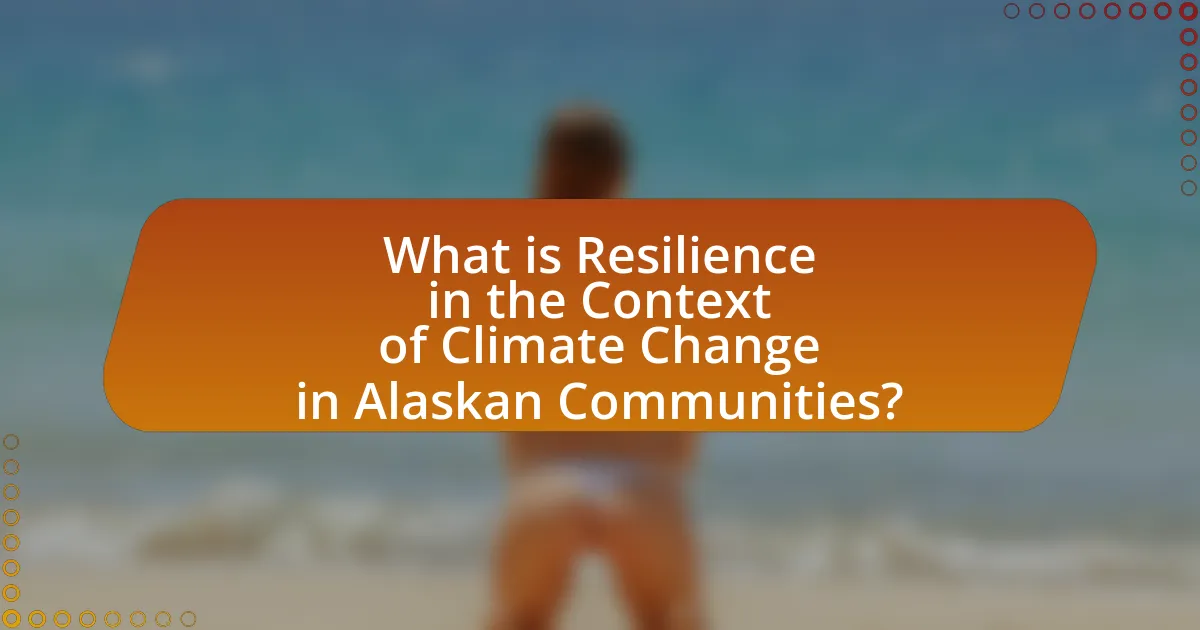
What is Resilience in the Context of Climate Change in Alaskan Communities?
Resilience in the context of climate change in Alaskan communities refers to the ability of these communities to anticipate, prepare for, respond to, and recover from the impacts of climate change. This includes adapting infrastructure, enhancing food security, and preserving cultural practices in the face of challenges such as melting permafrost, rising sea levels, and changing ecosystems. For instance, a study by the Alaska Native Tribal Health Consortium highlights that many Alaskan communities are implementing traditional ecological knowledge alongside modern science to develop adaptive strategies, demonstrating their proactive approach to resilience.
How do Alaskan communities define resilience?
Alaskan communities define resilience as the ability to adapt to and recover from the impacts of climate change while maintaining their cultural identity and social cohesion. This definition encompasses not only the physical capacity to withstand environmental changes but also the social and economic frameworks that support community well-being. For instance, many Alaskan communities emphasize the importance of traditional knowledge and practices, which have been passed down through generations, as essential components of their resilience strategy. This approach is supported by studies indicating that communities that integrate indigenous knowledge with modern science are better equipped to face climate-related challenges.
What factors contribute to the resilience of these communities?
The resilience of Alaskan communities is primarily contributed by strong social networks, adaptive governance, and traditional ecological knowledge. Strong social networks enable community members to support each other during crises, fostering collaboration and resource sharing. Adaptive governance allows for flexible decision-making that can respond to changing environmental conditions, ensuring that policies are relevant and effective. Traditional ecological knowledge, passed down through generations, provides valuable insights into sustainable practices and local environmental changes, enhancing the community’s ability to adapt to climate change impacts. These factors collectively empower communities to withstand and recover from climate-related challenges.
How does cultural heritage influence resilience in Alaskan communities?
Cultural heritage significantly influences resilience in Alaskan communities by providing a framework for identity, social cohesion, and traditional knowledge essential for adaptation to climate change. The preservation of indigenous practices, languages, and customs fosters a strong sense of community, which is crucial during environmental challenges. For instance, the use of traditional ecological knowledge, as documented in studies like “Indigenous Knowledge and Climate Change” by the Arctic Council, demonstrates how local practices inform sustainable resource management and disaster preparedness. This integration of cultural heritage into resilience strategies enhances the ability of these communities to respond effectively to climate impacts, thereby reinforcing their overall adaptability and survival.
Why is building resilience crucial for Alaskan communities facing climate change?
Building resilience is crucial for Alaskan communities facing climate change because it enables them to adapt to rapidly changing environmental conditions and mitigate the impacts of climate-related events. Alaskan communities are experiencing significant challenges such as increased flooding, erosion, and thawing permafrost, which threaten infrastructure, livelihoods, and cultural heritage. For instance, a report from the Alaska Climate Adaptation Science Center highlights that many coastal villages are at risk of being submerged due to rising sea levels, necessitating proactive measures to enhance resilience. By investing in adaptive strategies, such as improved infrastructure and community planning, these communities can better withstand climate impacts and ensure their long-term sustainability.
What specific climate change impacts are Alaskan communities experiencing?
Alaskan communities are experiencing significant climate change impacts, including increased temperatures, melting permafrost, and rising sea levels. These changes lead to infrastructure damage, loss of traditional hunting grounds, and increased flooding. For instance, the Arctic has warmed at nearly twice the global average, resulting in permafrost thawing, which destabilizes buildings and roads. Additionally, coastal erosion is exacerbated by rising sea levels, threatening villages like Newtok, which faces relocation due to these environmental changes.
How does climate change threaten the livelihoods of these communities?
Climate change threatens the livelihoods of Alaskan communities primarily through the disruption of traditional subsistence activities, such as fishing and hunting. As temperatures rise, ice patterns change, leading to reduced access to hunting grounds and altering fish migration patterns, which directly impacts food security and economic stability. For instance, a study by the National Oceanic and Atmospheric Administration (NOAA) indicates that warmer waters have led to a decline in certain fish populations, affecting local fisheries that many communities rely on for income and sustenance. Additionally, increased coastal erosion and flooding due to rising sea levels threaten infrastructure and homes, further jeopardizing the economic foundations of these communities.
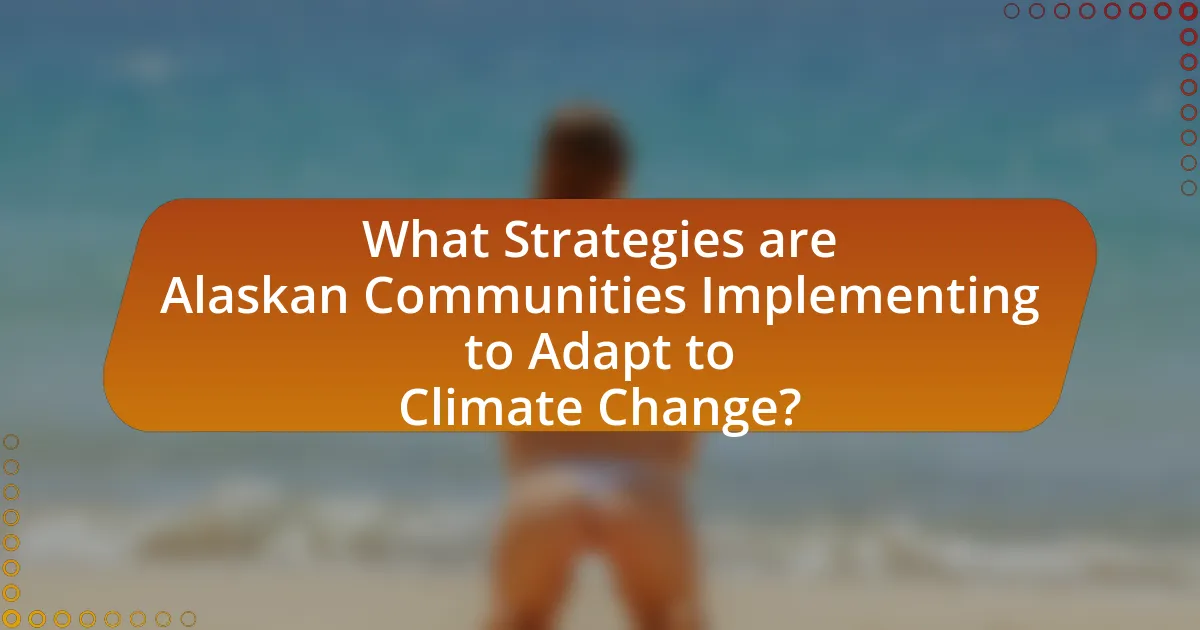
What Strategies are Alaskan Communities Implementing to Adapt to Climate Change?
Alaskan communities are implementing various strategies to adapt to climate change, including the construction of seawalls, relocation of infrastructure, and the development of community-based resource management plans. Seawalls are being built to protect against rising sea levels and increased erosion, particularly in coastal villages like Shishmaref, where the community has faced significant land loss. Additionally, some communities are relocating critical infrastructure, such as roads and utilities, to higher ground to mitigate the impacts of flooding and thawing permafrost. Furthermore, local resource management plans are being developed to ensure sustainable use of natural resources, which helps communities adapt to changing ecosystems and maintain food security. These strategies are essential as they address the immediate threats posed by climate change while promoting long-term resilience.
How are local governments involved in resilience-building efforts?
Local governments play a crucial role in resilience-building efforts by implementing policies and programs that address climate change impacts. They engage in planning and zoning regulations that promote sustainable development, invest in infrastructure improvements to withstand extreme weather events, and facilitate community education on climate adaptation strategies. For instance, the Alaska Climate Adaptation Science Center highlights how local governments collaborate with state agencies and community organizations to develop tailored resilience plans that reflect the unique needs of their communities. This involvement is essential for fostering adaptive capacity and ensuring that local populations can effectively respond to climate-related challenges.
What policies have been enacted to support adaptation strategies?
Policies enacted to support adaptation strategies in Alaskan communities include the Alaska Climate Adaptation Science Center’s initiatives, which focus on research and data collection to inform local decision-making. Additionally, the State of Alaska has implemented the Alaska Climate Change Strategy, which outlines actions to enhance community resilience against climate impacts. These policies are backed by funding from federal programs such as the Federal Emergency Management Agency (FEMA) and the National Oceanic and Atmospheric Administration (NOAA), which provide resources for infrastructure improvements and community planning efforts aimed at climate adaptation.
How do community-led initiatives contribute to resilience?
Community-led initiatives enhance resilience by fostering local engagement and adaptive capacity in the face of climate change. These initiatives empower residents to identify specific vulnerabilities and collaboratively develop solutions tailored to their unique environmental and social contexts. For instance, in Alaskan communities, local knowledge is integrated into planning processes, which has been shown to improve disaster preparedness and response strategies. Research indicates that communities actively involved in decision-making processes are better equipped to adapt to changing conditions, as evidenced by the successful implementation of traditional ecological knowledge in resource management.
What role does education play in enhancing community resilience?
Education plays a crucial role in enhancing community resilience by equipping individuals with knowledge and skills necessary to adapt to changing environmental conditions. In the context of Alaskan communities facing climate change, education fosters awareness about local ecosystems, promotes sustainable practices, and encourages community engagement in resilience-building initiatives. For instance, programs that teach traditional ecological knowledge alongside modern scientific approaches enable communities to develop adaptive strategies that are culturally relevant and effective. Research indicates that communities with higher levels of education are better prepared to respond to climate-related challenges, as they can access information, collaborate effectively, and implement innovative solutions.
How are schools and educational programs addressing climate change awareness?
Schools and educational programs are addressing climate change awareness by integrating climate education into their curricula and promoting sustainability initiatives. For example, many Alaskan schools incorporate local environmental issues into lessons, emphasizing the impact of climate change on their communities. Programs like the Alaska Climate Adaptation Science Center provide resources and training for educators to teach students about climate science and adaptation strategies. Additionally, hands-on projects, such as community clean-ups and renewable energy workshops, engage students in practical solutions, fostering a deeper understanding of climate change and its effects on their environment.
What training opportunities exist for community members to build resilience skills?
Training opportunities for community members to build resilience skills include workshops, community-based training programs, and online courses focused on climate adaptation strategies. These programs often emphasize practical skills such as emergency preparedness, sustainable resource management, and community planning. For instance, the Alaska Native Tribal Health Consortium offers training that equips participants with knowledge on health impacts related to climate change, fostering resilience in local communities. Additionally, organizations like the University of Alaska Fairbanks provide educational resources and training sessions aimed at enhancing community capacity to respond to environmental changes.
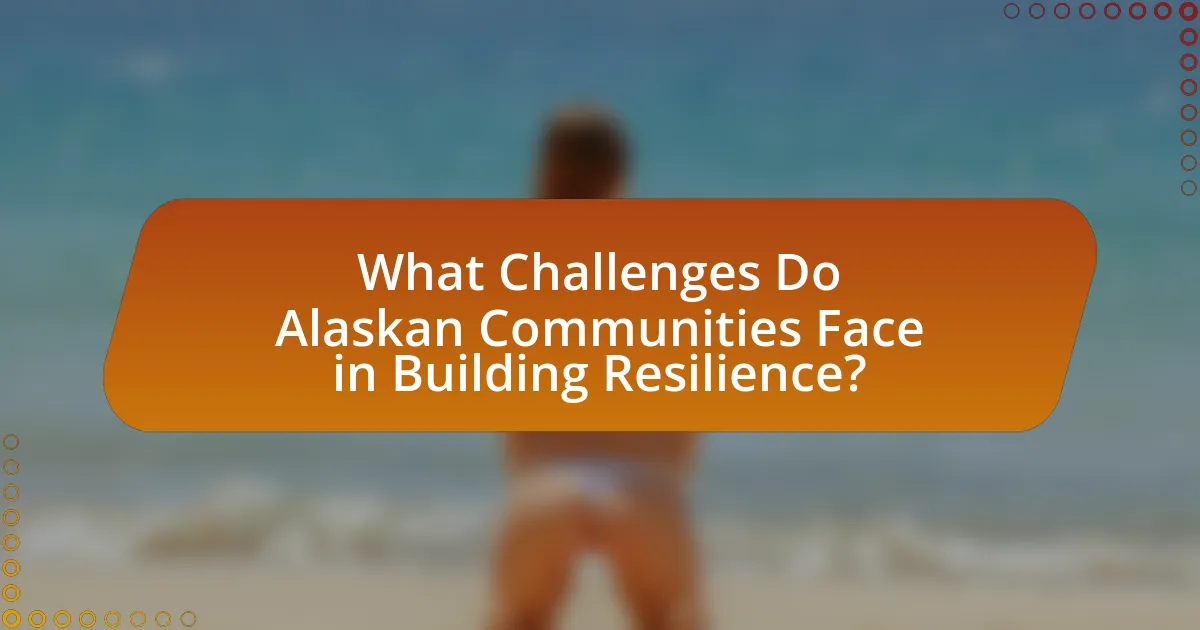
What Challenges Do Alaskan Communities Face in Building Resilience?
Alaskan communities face significant challenges in building resilience to climate change, primarily due to extreme weather events, rising sea levels, and permafrost thawing. These environmental changes threaten infrastructure, disrupt traditional livelihoods, and increase the risk of natural disasters. For instance, the National Oceanic and Atmospheric Administration (NOAA) reports that Alaska is warming at twice the rate of the rest of the United States, leading to increased coastal erosion and flooding. Additionally, the loss of sea ice affects hunting and fishing practices, which are vital for food security and cultural identity. These factors collectively hinder the ability of Alaskan communities to adapt and implement effective resilience strategies.
What are the financial barriers to implementing resilience strategies?
The financial barriers to implementing resilience strategies include high upfront costs, limited funding sources, and ongoing maintenance expenses. High upfront costs deter communities from investing in necessary infrastructure improvements and adaptation measures, as these can require significant capital that may not be readily available. Limited funding sources, such as grants and loans, often do not cover the full scope of resilience projects, leaving communities to seek additional financial support. Ongoing maintenance expenses further strain budgets, as communities must allocate resources for the upkeep of resilience measures over time. According to a report by the National Oceanic and Atmospheric Administration, many Alaskan communities face these financial challenges, which hinder their ability to effectively adapt to climate change impacts.
How do funding limitations affect community adaptation projects?
Funding limitations significantly hinder community adaptation projects by restricting the resources necessary for effective implementation. Without adequate financial support, communities struggle to develop and execute strategies that address climate change impacts, such as infrastructure improvements or disaster preparedness initiatives. For instance, a study by the National Oceanic and Atmospheric Administration (NOAA) found that communities with limited funding often cannot afford essential assessments or technologies needed for adaptation, leading to increased vulnerability to climate-related hazards. This lack of investment not only delays critical projects but also exacerbates existing risks, ultimately undermining community resilience in the face of climate change.
What role do external economic factors play in these challenges?
External economic factors significantly influence the challenges faced by Alaskan communities in adapting to climate change. These factors include fluctuations in global commodity prices, which can affect local economies reliant on fishing, oil, and tourism. For instance, a decline in oil prices can reduce state revenue, limiting funding for climate adaptation projects. Additionally, changes in international demand for seafood can impact local fisheries, leading to economic instability. According to the Alaska Department of Revenue, a 30% drop in oil prices in 2015 resulted in a $3 billion budget deficit, highlighting the direct correlation between external economic conditions and the capacity for communities to respond to climate-related challenges.
How does the geographic isolation of Alaskan communities impact resilience efforts?
The geographic isolation of Alaskan communities significantly hinders resilience efforts by limiting access to resources, information, and support networks. This isolation results in challenges such as delayed emergency response times, restricted transportation options, and difficulties in obtaining supplies necessary for adaptation to climate change. For instance, many remote communities rely on air transport for essential goods, which can be disrupted by weather conditions, thereby affecting their ability to respond to climate-related events. Additionally, the lack of connectivity can impede collaboration with external organizations that provide technical assistance and funding for resilience projects, further exacerbating vulnerabilities.
What logistical challenges arise from remote locations?
Remote locations face significant logistical challenges, primarily due to limited access to transportation and infrastructure. These areas often lack reliable roads, making it difficult to transport goods and services, which can lead to delays in essential supplies. For instance, in Alaskan communities, the harsh climate and geographical isolation exacerbate these issues, resulting in increased costs for shipping and a reliance on air transport, which is not always feasible. Additionally, the limited availability of local resources can hinder emergency response efforts and the delivery of healthcare services, as seen during natural disasters when timely access is critical.
How does isolation affect access to resources and support networks?
Isolation significantly limits access to resources and support networks by reducing communication and transportation options. In remote Alaskan communities, geographical isolation often leads to decreased availability of essential services, such as healthcare, education, and social support. For instance, a study by the Alaska Department of Health and Social Services found that isolated communities face higher rates of health issues due to limited access to medical facilities and professionals. Furthermore, social isolation can hinder community engagement and collaboration, making it challenging for residents to share resources or seek assistance during crises, such as those posed by climate change.
What are the best practices for enhancing resilience in Alaskan communities?
The best practices for enhancing resilience in Alaskan communities include developing community-based adaptation plans, investing in infrastructure improvements, and fostering local knowledge and leadership. Community-based adaptation plans allow residents to identify specific vulnerabilities and prioritize actions tailored to their unique circumstances. For instance, the Alaska Native Tribal Health Consortium has implemented strategies that incorporate traditional ecological knowledge to address health impacts from climate change. Infrastructure improvements, such as elevating buildings and enhancing drainage systems, mitigate risks from flooding and erosion, as evidenced by the successful projects in communities like Newtok. Additionally, fostering local knowledge and leadership empowers residents to take proactive measures, as seen in the collaborative efforts of the Alaska Climate Adaptation Science Center, which engages local communities in research and decision-making processes. These practices collectively enhance the resilience of Alaskan communities against climate change impacts.
How can communities effectively collaborate with external organizations?
Communities can effectively collaborate with external organizations by establishing clear communication channels and shared goals. This involves identifying common interests, such as climate resilience, and engaging in regular dialogue to align strategies. For instance, the Alaska Native Tribal Health Consortium has partnered with local communities to address health impacts related to climate change, demonstrating the effectiveness of collaborative efforts. Such partnerships can leverage resources, expertise, and funding, ultimately enhancing the community’s adaptive capacity to climate challenges.
What innovative solutions have proven successful in other regions?
Innovative solutions that have proven successful in other regions include the implementation of community-based adaptation strategies, such as the use of traditional ecological knowledge in Pacific Island nations. These strategies involve local communities actively participating in decision-making processes regarding climate resilience, which has led to improved resource management and enhanced adaptive capacity. For instance, in the Philippines, the integration of mangrove restoration with disaster risk reduction has significantly reduced vulnerability to storm surges and flooding, demonstrating a successful model for combining environmental restoration with community safety.
